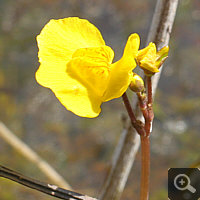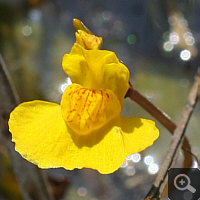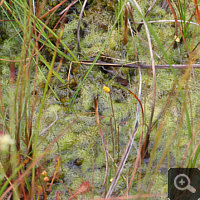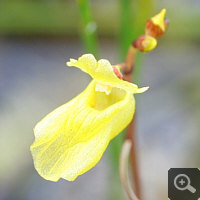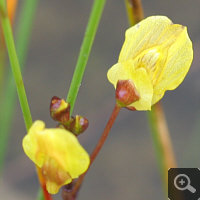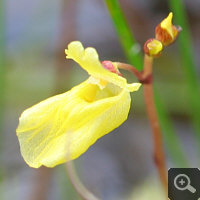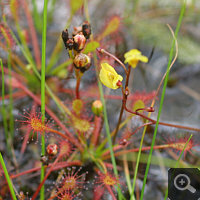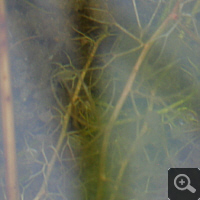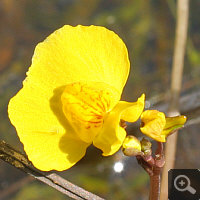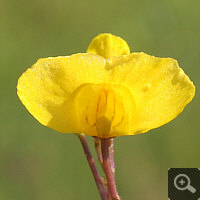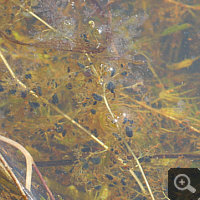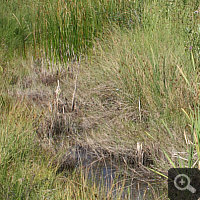Bladderworts (Utricularia) in their natural German habitat
Introduction
The genus Utricularia represents with circa 220 species worldwide the second largest group of carnivorous plants. Anatomy of Utricularias is complex and between the several species furthermore yet divergent. To avoid at this point a detailed excursion into botanical nomenclature, I reduce somewhat the structure of bladderworts, albeit in that case this is anatomically not entirely accurate. Utricularias have no roots, to put it simply they consist of sprouts, traps, leaves and blossoms.
The carnivorous bladderworts (Utricularia) have realised as the only plant genus the principle of bladder traps, which are a highly refined and complex trap system. Bladderworts produce as traps small bladders, whose size vary considerably between different species. The diametre varies between 1 – 10 mm. In the bladders wall are small pumps installed, which pump water from the inside outwards, whereby a negative pressure is produced and the bladder is dented inwards. In addition, the bladder shows a small opening, which is closed by a valve. At the valve are several bristles, which release the trap in contact. If a prey (mainly wheel animals, water fleas and nematodes; by larger bladders also mosquito larvae) gets at a bristle, this acts as lever, with which the prey releases the valve from its anchor. Through the negative pressure the valve and with this also some water and the prey, which was in front of the valve, are sucked inwards.
After a complete pressure balance the valve closes again. The whole process only takes 0.02 seconds and is therefore the second fastest movement in plant kingdom. Faster is only the Canadian bunchberry (Cornus canadensis), which catapults, in the case of contact, its pollen to the top within 0,3 ms. Then pumps begin again to suck water out and to renew thereby the negative pressure. Parallel other pumps secrete digestive enzymes, with which the prey is utilized.
In Germany are seven species native, namely Utricularia australis, Utricularia bremii, Utricularia intermedia, Utricularia minor, Utricularia ochroleuca, Utricularia stygia and Utricularia vulgaris. All German species grow aquatic, i.e. in water afloat sumersed. The most frequent species are the Common Bladderwort (Utricularia vulgaris) and the Southern Bladderwort (Utricularia australis), which can produce up to 2 m long sprouts. You can find both species quite often in fens, but also in other not too nutrient-rich waters. The remaining five species stay distinctly smaller and are to be found almost exclusively in raised bog ditches.
Lesser Bladderwort (Utricularia minor)
The Lesser Bladderwort (Utricularia minor) is scarce in Germany and endangered. On the one hand, the species is to be found still frequently in North and East Germany. A further main area of distribution is Southern Bavaria. By contrast is the species very rare in the rest of Germany.
Utricularia minor populates nutrient-poor and acid waters. Therefore it is to find in ditches and ponds in transition und raised bogs. There it is often accompanied by the three native sundew species. Especially the Oblong-leaved Sundew (Drosera intermedia) is found in the immediate vicinity, which grows quite often half-aquatic.
The Lesser Bladderwort is a rootless submersed aquatic plant, whose sprouts remain very short and reach seldom a length of more als 20 cm.
In contrast to the great native bladderwort species are the sprouts rather sparsely equipped with bladders, although these are in no way inferior to their great relatives regarding efficiency.
In July and August appear the rather light yellow to sulphur-yellow blossoms. These are very small. Upper and lower lip build an acute angle, the lateral parts of the lower lip tilt downwards, so that the lip from above seems rather small. Partly has the lower lip a subtle, reddish maculation.
Early August 2012 I have found the species within a transition bog in the Allgäu. Impressing was the mass occurrence. The species was accompanied in its biotope by Drosera anglica, Drosera intermedia, Drosera rotundifolia and Hammarbya paludosa, an extremely rare bog orchid.
Southern Bladderwort (Utricularia australis)
The most frequent species is probably the Common Bladderwort (Utricularia vulgaris). But the Southern Bladderwort (Utricularia australis) is in Germany not considerably less frequent.
The species was 1810 by Robert Brown described and is today classed into the section Utricularia of the same-named subgenus. The Southern Bladderwort is of hybridogenetic origin – it developed from a Japanese natural hybrid between Utricularia tenuicaulis and Utricularia macrorhiza. From Japan the species distributed westwards over Asia as far away as Europe, southwards it reached Africa and Australia. In Germany, the species is found in oligotrophic to eutrophic waters as in ponds, waters in fens and peat-cutting sites. It are populated both acid and alkaline waters.
The Southern Bladderwort is a rootless submersed aquatic plant, whose sprouts can reach up to 2 m length. The sprouts are replete with bladders. The traps are highly effective. In summer are almost all bladders due to the caught prey coloured black.
In July and August appear very beautiful blossoms. These are comparatively large, lushly yellow in basic colour. The lower lip of the corolla shows as a rule a fine, reddish pattern of stripes.
Utricularia australis is to differentiate from Utricularia vulgaris only on the basis of the blossom. Utricularia vulgaris is fertile, produces therefore seeds, whereas Utricularia australis is sterile. The lower lip of the corolla is in the case of Utricularia australis spread flat and builds with the upper lip a right to obtuse angle. By contrast lateral parts of the lower lip tilt downwards in the case of Utricularia vulgaris, the lower lip of the corolla builds with the upper lip an acute angle.
I have found this species in several fens in South Germany yet, where it grows quite often in small ponds in masses.

